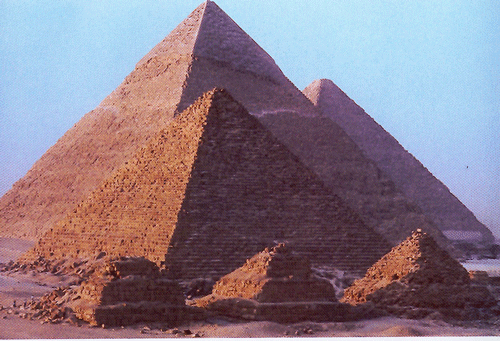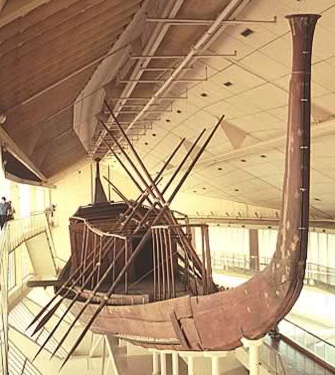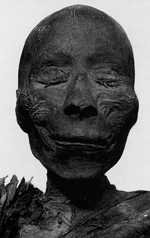
The three big pyramids you see above are at Giza, a plateau of rock on the south west outskirts of Cairo. They belonged to three pharaohs: Khufu built the biggest one, the Great Pyramid (the one at the back), his son Khafre had the second, and the third belonged to Khafre's son Menkaure. The little ones belonged to queens. Here are some more cool facts about the pyramids:
Why were the pyramids built?
The pyramids are whopping great tombs for these kings. Inside them are tunnels and chambers where they kings were buried with their treasures. But why are they pyramid shapes?
There are a few theories. Some say the pyramids represent the primeval mound - the very beginning of the world when the gods created earth which rose out of the waters. Others say that they are something like a stairway to heaven, for the pharaoh to rise to the sky to be with the sun god. The tip was capped with gold so it would have shone brightly like the sun, and some also say that the pyramid shape stands for the sloping rays of the sun.
There are narrow tunnels leading from the chambers inside the Great Pyramid which point to the stars - in fact the stars which never set below the horizon, which the Egyptians called the Imperishable Ones. It was believed that after death pharaoh would rise to live among these stars, becoming one of them. So were these tunnels for the pharaoh's soul to use? Or just air shafts, for his soul to breathe when in the burial chamber? Another theory is that they were guidelines, to help the Egyptians set the stones properly in place as the levels rose higher and higher.
Maybe these huge constructions were just the pharaoh's way of making sure people remembered him for thousands of years to come. What do you think?
How were the pyramids made?
Egyptologists think the limestone blocks for the pyramids were quarried nearby then pulled either on wooden sleds or logs by teams of men. 85% of all the stones came from a quarry which we can still see close to the pyramid. Some stones were of higher quality stone (e.g. the outer casing) which had to be brought by boat form other parts of Egypt.
Ramps made of mud brick were built so the blocks could be pulled up and placed in position. After all the main blocks were positioned, the outer casing was added so the pyramid had smooth sides. This casing has now gone, except for some at the top of Khafre's pyramid. It was all 'borrowed' to make the houses of the nearby villages.
The workers were probably of two main types - skilled masons and overseers who cut the blocks and made sure they were arranged properly, and peasants who were drafted in to do the hard work - pulling those huge blocks. But none of these were slaves. The image you see in old films of guards whipping wretched slaves is wrong. The workers were well looked after and even had doctors to mend broken bones.
Fascinating Facts:
- The Great Pyramid was one of the seven wonders of the ancient world. It is about 2000 years older than all the rest, and yet it is the only one that still stands!
- The Great Pyramid is 147m high - that's 451 feet. To compare, it's in between Big Ben, which is 320 feet, and Blackpool Tower, which is 518 feet.
- It's made of limestone - that is, the remains of sea creatures from millions of years ago.
- You can see shells in the blocks of stone.
- There are about 2,300,000 blocks which weigh on average 2.5 tons, although some at the bottom are more like 15 tons.
- The workers, in a ten hour day, set in place one block every 1 or 2 minutes. That's hard to believe!
- The construction of the Great Pyramid is amazingly accurate. There is no more than a 4.4 cm difference between the length of any two sides. The base is so flat that no part is more than 2.1 cm higher than any other. And the sides are aligned almost exactly to the cardinal points (that means north, south, east, west).
- Because of the accuracy with which the pyramid is pointed to certain stars, and the fact that over time the earth points slightly differently to these stars, we know to within a few years when the Great Pyramid was built - 2478BC.
- According to a new book by John Romer, the Great Pyramid took about 14 years to build. At first 25,000 workers were involved but fewer were needed as the levels grew smaller.
- Next to the Great Pyramid two pits were dug and all the parts of two boats put inside. One of these boats was found in 1954 and put back together, and you can now see it in a museum next to the pyramid (see below). The other pit has been investigated with a camera but resealed to protect the boat.

Mummification


Thutmose I Thutmose II
The Egyptians mummified people for thousands of years. Usually it was only the rich - nobles and the royal family - who could afford to be properly mummified. Poor people would have a simple grave in the desert, under the sand.
Amazingly, many of the famous kings' mummies have survived. Above we can see the head of Thutmose I, who was Hatshepsut's father, and of Thutmose II, who was her husband. We also have the remains of one of the most famous of all the pharaohs, Ramses II (see below). All of these kings are now in the Cairo Museum. Tutankhamun's body, however, remains in its tomb.
 Why did the
Egyptian mummify people?
Why did the
Egyptian mummify people?
The Egyptians believed that every person had a ka, which means their life force or spirit. After death the ka could travel to the underworld, but it needed to return to the body to get sustenance. If the body was decayed or could not be recognized the ka would go hungry, which was bad news for its survival in the afterlife. This is why the body had to be preserved. Sometimes faces would have make up applied to keep them looking good, or masks would be put on the head to show the person in good health (like Tutankhamun's mask).
How did they mummify people?
Mummification was a long process. First the body was washed, then all the organs were removed except the heart (needed for the weighing of the heart in the afterlife) and the kidneys. The brain was pulled out with a hook and thrown away (the Egyptians thought that the heart was what we used for thinking and feeling, so the brain was unimportant).
Next the body was dried out using a special salt called natron (similar to baking powder). The body was completely covered in mounds of it and left for 40 days. After this the body and organs were thoroughly dried out, the body was packed with more natron and linen cloth to give it a more natural shape.
Next the body was coated in resin (sticky stuff from trees), which made the skin darker. So much resin was poured over Tutankhamun that Howard Carter had a very difficult time getting him out of his coffin.

wooden coffin
At last the body was wrapped in linen bandages, with magic amulets inserted to give protection. The bandaging took 15 days, and the whole process about 70 days. After mummifying the lungs, stomach, intestines, and liver were put in special containers we call Canopic jars. All this time the workers were watched over by priests - one who wore a mask of Anubis, his assistant, and one who read out magic spells to ensure the body was preserved and made its way to the afterlife.
Finally the burial could take place, with many prayers and religious rites, and the person was placed in his coffins and his tomb along with his possessions.

sarcophagus of Amenhotep II
Taweret
 Taweret
was the goddess of childbirth, popular with the peasants. She was shown in
the form of a hippopotamus, often with the arms and legs of a lion and the
back and tail of a crocodile. Her name means 'the Great Goddess'. People
would pray to her to protect the mother in childbirth, a very dangerous time
for women not only in ancient Egypt but for most of history. Taweret was
shown as a hippopotamus because these creatures are very protective toward
their young.
Taweret
was the goddess of childbirth, popular with the peasants. She was shown in
the form of a hippopotamus, often with the arms and legs of a lion and the
back and tail of a crocodile. Her name means 'the Great Goddess'. People
would pray to her to protect the mother in childbirth, a very dangerous time
for women not only in ancient Egypt but for most of history. Taweret was
shown as a hippopotamus because these creatures are very protective toward
their young.
Taweret did not have temples, but her statues would be found in many homes, in special niches in the wall so the family could pray to her and make offerings.
Click here to learn about hieroglyphs